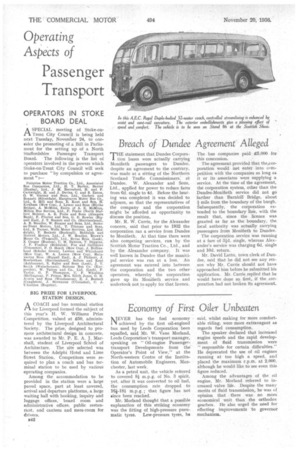Economy of First Oiler Unbeaten N EVER has the fuel economy
Page 56

If you've noticed an error in this article please click here to report it so we can fix it.
achieved by the first oil-engined bus used by Leeds Corporation been equalled, said Mr. W. Vane Morland, Leeds Corporation's transport manager, speaking on "Oil-engine Passenger transportDevelopments from the Operator's Point of View," at the North-western Centre of the Institution of Automobile Engineers, Manchester, last week.
As a petrol unit, the vehicle referred to covered 8i m.p.g. of No. 3 spirit, yet, after it was converted to oil fuel, the consumption rate dropped to 164-181 m.p.g. ; that figure has not since been reached.
Mr. Morland thought that a possible explanation of this striking economy was the fitting of high-pressure pneumatic tyres. Low-pressure tyres, he said, whilst making for more comfortable riding, were more extravagant as regards fuel consumption.
The speaker declared that increased engine speeds and the rapid development of fluid transmission were " responsible for certain difficulties." He deprecated the use of oil engines running at too high a speed, and placed the maximum r.p.m. at 2,000, although he would like to see even this figure reduced. Among the advantages of the oil engine, Mr. Morland referred to increased valve life. Despite the many merits of fluid transmission, he was of opinion that there was no mare economical unit than the orthodox gearbox. He also urged the need for effecting improvements to governor mechanism,




























































































